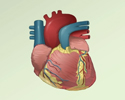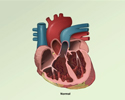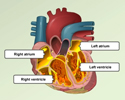Electrocardiogram
An electrocardiogram (ECG) is a test that records the electrical activity of the heart.
Electrocardiogram - Animation
If your heart has been beating too fast, or you've been having chest pain, both you and your doctor will want to find out what's causing the problem so you can get it treated. One way to diagnose heart problems is with a test of the heart's electrical activity, called an electrocardiogram or ECG, or EKG for short. Your heart is controlled by an electrical system, much like the electricity that powers the lights and appliances in your home. Electrical signals make your heart contract so that it can pump blood out to your body. Heart disease, abnormal heart rhythms, and other heart problems can affect those signals. Using an ECG, your doctor can identify problems in your heart's electrical system and diagnose heart disease. So, how is an ECG done? First you'll lie down on a table. You'll have to lie very still while the test is done. Small patches, called electrodes, will be attached to several places on your arms, legs, and chest. The patches won't hurt, but some of the hair in those areas may be shaved so the patches will stick to your skin. The patches are then attached to a machine. You'll notice that when the machine is turned on, it produces wavy lines on a piece of paper. Those lines represent the electrical signals coming from your heart. If the test is normal, it should show that your heart is beating at an even rate of 60 to 100 beats per minute. Many different heart conditions can show up on an ECG, including a fast, slow, or abnormal heart rhythm, a heart defect, coronary artery disease, heart valve disease, or an enlarged heart. An abnormal ECG may also be a sign that you've had a heart attack in the past, or that you're at risk for one in the near future. If you're healthy and you don't have any family or personal history of heart disease, you don't need to have an ECG on a regular basis. But if you are having heart problems, your doctor may recommend getting this test. An ECG is pretty accurate at diagnosing many types of heart disease, although it doesn't always pick up every heart problem. You may have a perfectly normal ECG, yet still have a heart condition. If your test is normal but your doctor suspects that you have a heart problem, he may recommend that you have another ECG, or a different type of test to find out for sure.
How the Test is Performed
You will be asked to lie down. A technician will clean several areas on your arms, legs, and chest, and then will attach small patches called electrodes to those areas. It may be necessary to shave or clip some hair so the patches stick to the skin. The number of patches used may vary.
The patches are connected by wires to a machine that turns the heart's electrical signals into wavy lines, which are often printed on paper. The health care provider reviews the test results.
You will need to remain still during the procedure. The technician may also ask you to hold your breath for a few seconds as the test is being done.
It is important to be relaxed and warm during an ECG recording because any movement, including shivering, can alter the results.
Sometimes this test is done while you are exercising or under light stress to look for changes in the heart. This type of ECG is often called a stress test.
Electrocardiogram - ECG - recording - Animation
An ECG represents a composite recording of all the action potentials generated by all cardiac muscle cells during each heartbeat. To record an ECG, 12 metal electrodes are positioned on the arms, legs, and chest. These electrodes detect the heart electric activity and transmit it to the electrocardiograph, which amplifies and records the signals. The twelve electrodes, or leads, are placed on the body to obtain 6 limb leads and 6 chest leads. Together, these leads provide a 3-dimensional representation of the heart electric activity. Each lead is analogous to a video camera recording the same event, atrial and ventricular depolarization, and repolarization from a different angle. Therefore, each limb or chest lead record slightly different electric activity of the heart. This results in the electrocardiograph producing 12 different tracings. By comparing these recordings with one another, and with normal tracings, physicians can detect heart abnormalities, including the presence of arrhythmia, enlargement of left ventricle, abnormalities in the cardiac conduction system, and damage to certain regions of the heart.
How to Prepare for the Test
Make sure your provider knows about all the medicines you are taking. Some medicines can interfere with test results.
Do not exercise or drink cold water immediately before an ECG because these actions may cause false results.
How the Test will Feel
An ECG is painless. No electricity is sent through the body. The electrodes may feel cold when first applied. In rare cases, some people may develop a rash or irritation where the patches were placed.
Why the Test is Performed
An ECG is used to measure:
- Any damage to your heart
- How fast your heart is beating and whether it is beating normally
- The effects of medicines or devices used to control your heart (such as a pacemaker)
Pacemaker
A pacemaker is a small, battery-operated device. This device senses when your heart is beating too slowly. It sends a signal to your heart that mak...
 ImageRead Article Now Book Mark Article
ImageRead Article Now Book Mark Article - The size and position of your heart chambers
Cardiac arrhythmia tests: ECG and EKG - Animation
Definite diagnosis and analysis of arrhythmia is done through ECG recording. Physicians analyze the shape and size of ECG waves and wave intervals, as well as rate and regularity of rhythm. This analysis allows physicians to determine the rate of atrial activation, the rate and regularity of ventricular activation, and the relationship between atrial and ventricular activations.
An ECG is often the first test done to determine whether a person has heart disease. Your provider may order this test if:
Heart disease
Coronary heart disease is a narrowing of the blood vessels that supply blood and oxygen to the heart. Coronary heart disease (CHD) is also called co...

- You have chest pain or palpitations
Chest pain
Chest pain is discomfort or pain that you feel anywhere along the front of your body between your neck and upper abdomen.
 ImageRead Article Now Book Mark Article
ImageRead Article Now Book Mark ArticlePalpitations
Palpitations are feelings or sensations that your heart is pounding or racing. They can be felt in your chest, throat, or neck. You may:Have an unpl...
 ImageRead Article Now Book Mark Article
ImageRead Article Now Book Mark Article - You are scheduled for surgery
- You have had heart problems in the past
- You have a strong history of heart disease in the family
Normal Results
Normal test results most often include:
- Heart rate: 60 to 100 beats per minute
- Heart rhythm: Consistent and even
What Abnormal Results Mean
Abnormal ECG results may be a sign of:
- Damage or changes to the heart muscle
- Changes in the amount of the electrolytes (such as potassium and calcium) in the blood
- Congenital heart defect
- Enlargement of the heart
Enlargement of the heart
Cardiomyopathy is disease in which the heart muscle becomes weakened, stretched, or has another structural problem. Dilated cardiomyopathy is a condi...
 ImageRead Article Now Book Mark Article
ImageRead Article Now Book Mark Article - Fluid or swelling in the sac around the heart
- Inflammation of the heart (myocarditis)
Inflammation of the heart
Pericarditis is a condition in which the sac-like covering around the heart (pericardium) becomes inflamed.
 ImageRead Article Now Book Mark Article
ImageRead Article Now Book Mark Article - Past or current heart attack
Heart attack
Most heart attacks are caused by a blood clot that blocks one of the coronary arteries. The coronary arteries bring blood and oxygen to the heart. ...
 ImageRead Article Now Book Mark Article
ImageRead Article Now Book Mark Article - Poor blood supply to the heart arteries
- Abnormal heart rhythms (arrhythmias)
Arrhythmias
An arrhythmia is a disorder of the heart rate (pulse) or heart rhythm. The heart can beat too fast (tachycardia), too slow (bradycardia), or irregul...
 ImageRead Article Now Book Mark Article
ImageRead Article Now Book Mark Article
Some heart problems that can lead to changes on an ECG test include:
- Atrial fibrillation/flutter
Atrial fibrillation/flutter
Atrial fibrillation (AFib) and atrial flutter are common types of abnormal heart rhythms (arrhythmias) which affect the upper chambers (atria) of the...
 ImageRead Article Now Book Mark Article
ImageRead Article Now Book Mark Article - Heart attack
- Heart failure
Heart failure
Heart failure is a condition in which the heart is no longer able to pump oxygen-rich blood to the rest of the body efficiently. This causes symptom...
 ImageRead Article Now Book Mark Article
ImageRead Article Now Book Mark Article - Multifocal atrial tachycardia
Multifocal atrial tachycardia
Multifocal atrial tachycardia (MAT) is a rapid heart rate. It occurs when too many signals (electrical impulses) are sent from the upper heart (atri...
 ImageRead Article Now Book Mark Article
ImageRead Article Now Book Mark Article - Paroxysmal supraventricular tachycardia
Paroxysmal supraventricular tachycardia
Paroxysmal supraventricular tachycardia (PSVT) is episodes of a rapid heart rate that start in a part of the heart above the ventricles. "Paroxysmal...
 ImageRead Article Now Book Mark Article
ImageRead Article Now Book Mark Article - Sick sinus syndrome
Sick sinus syndrome
Normally, the heartbeat starts in an area in the top chambers of the heart (atria). This area is the heart's pacemaker. It is called the sinoatrial...
 ImageRead Article Now Book Mark Article
ImageRead Article Now Book Mark Article - Wolff-Parkinson-White syndrome
Wolff-Parkinson-White syndrome
Wolff-Parkinson-White (WPW) syndrome is a condition in which there is an extra electrical pathway in the heart that leads to periods of rapid heart r...
 ImageRead Article Now Book Mark Article
ImageRead Article Now Book Mark Article
Risks
There are no risks.
Considerations
The accuracy of the ECG depends on the condition being tested. A heart problem may not always show up on the ECG. Some heart conditions never produce any specific ECG changes.
Reviewed By
Thomas S. Metkus, MD, Assistant Professor of Medicine and Surgery, Johns Hopkins University School of Medicine, Baltimore, MD. Also reviewed by David C. Dugdale, MD, Medical Director, Brenda Conaway, Editorial Director, and the A.D.A.M. Editorial team.
Brady WJ, Harrigan RA, Chan TC. Basic electrocardiographic techniques. In: Roberts JR, Custalow CB, Thomsen TW, eds. Roberts and Hedges' Clinical Procedures in Emergency Medicine and Acute Care. 7th ed. Philadelphia, PA: Elsevier; 2019:chap 14.
Ganz L, Link MS. Electrocardiography. In: Goldman L, Cooney KA, eds. Goldman-Cecil Medicine. 27th ed. Philadelphia, PA: Elsevier; 2024:chap 42.
Mirvis DM, Goldberger AL. Electrocardiography. In: Libby P, Bonow RO, Mann DL, Tomaselli GF, Bhatt DL, Solomon SD, eds. Braunwald's Heart Disease: A Textbook of Cardiovascular Medicine. 12th ed. Philadelphia, PA: Elsevier; 2022:chap 14.







 All rights reserved.
All rights reserved.